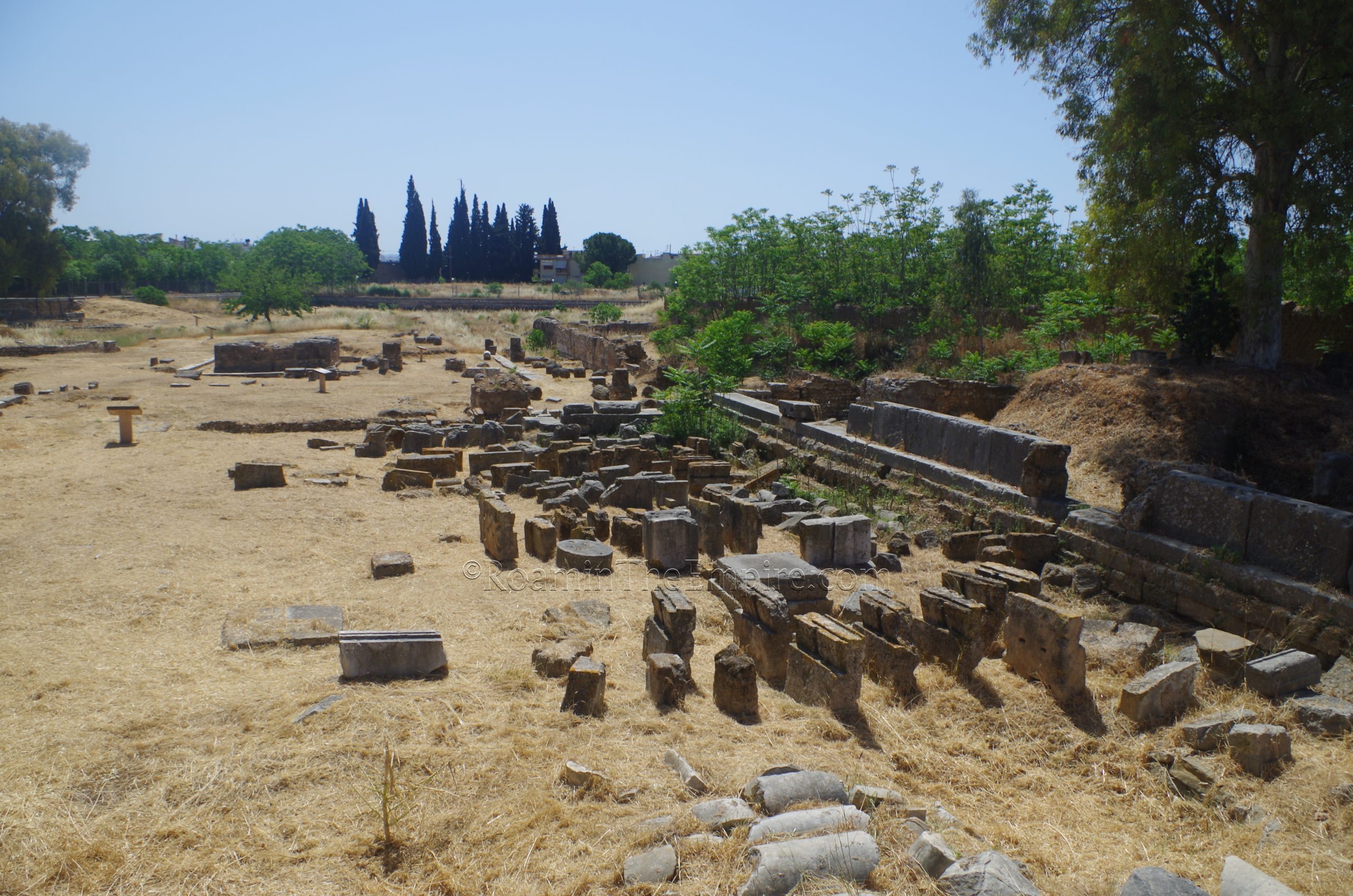
Just across the street to the east is the archaeological area of Argos’ agora. The agora has the same hours as the theater and is included in the admission ticket. Though it may generally be open. Two guys seemed to be there watching over things and acknowledged me when I tried to show them my ticket, but when I passed by later in the day, nobody was there and it was just kind of open. Maybe there is tighter control later in the summer when it is presumably busier.
Adjacent to the road, to the immediate right (south) of the entrance is the so called Column Hall or Column Room or Hypostyle Hall. This is the oldest structure in the Agora, dating back as far as perhaps 475 BCE. It is distinguishable by its large block construction. The building may have originally functioned as the bouleuterion of Argos. By the 3rd century CE, a bathing complex constructed to the east had incorporated this building into the floor plan. There’s not a whole lot left to see other than the robust southern wall made from the distinctive larger blocks.
The southern part of the excavated area of the agora is dominated by the Southern Gallery or Southern Stoa. Originally constructed between 450 BCE and 425 BCE, the structure was lined on three sides by a columned portico (north, east, and west sides). In the 1st century CE, the interior of the structure, within the colonnade, was converted into a palaestra. By the 3rd century CE, the northern part of the portico was extended to the Column Hall and the area was converted into Market space. The western part of the stoa was converted into a bathing complex, perhaps associated with the palaestra. Finally, in the 4th century CE, private residences were built on the spot. The west part is fairly accessible, but the eastern part is mostly overgrown and inaccessible.
From about 450 BCE to the 2nd century CE, a dromos ran in front of the Southern Gallery, but there are not really elements of the dromos visible today. Partially occupying the space of the dromos is a square structure; the Square Nymphaeum. This was built in the second half of the 2nd century CE and dedicated by the Tiberii Julii family. When the Southern Gallery was converted to residential structures in the 4th century CE, the Square Nymphaeum was also incorporated into the private residences.
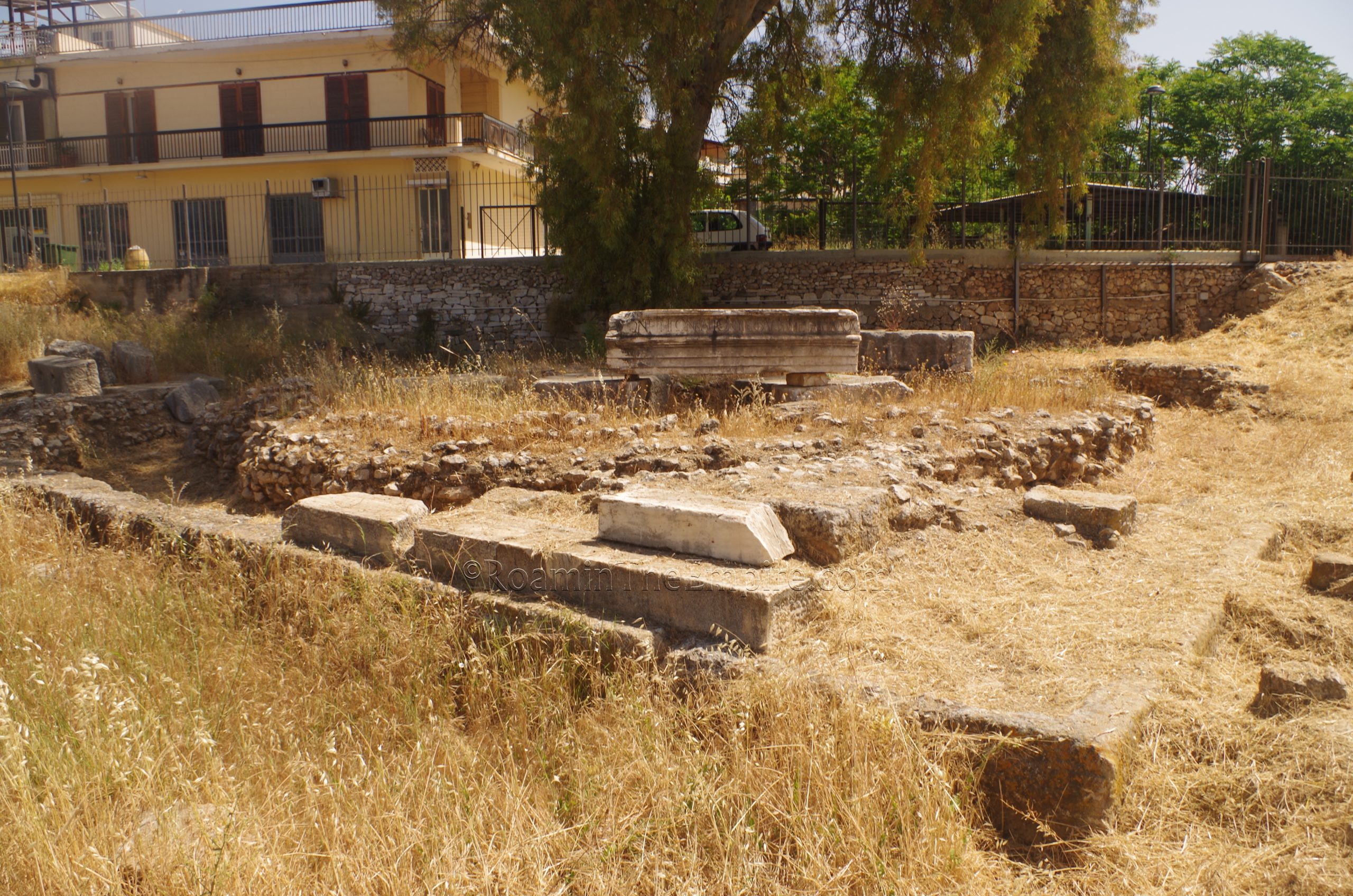
Another Roman monument on the space of the dromos can be found aligned roughly with the southeastern end of the Southern Gallery; the so-called Monument M. Built in the 2nd century CE, only the base of the structure survives. It is believed to be a funerary monument or cenotaph honoring an important resident. Pausanias describes there as being a number of these monuments in the agora of Argos. Unfortunately, not much of it is known beyond that, including who it may have been dedicated to.
Just to the north of Monument M is a round structure set on a square base, though only the west half is excavated; the modern road Archeas Voulis overlays part of it. Identified as a Tholos, the 1st century CE building was constructed on the crypt of an earlier structure of unknown function. Though the use of the Tholos is unknown, it may have been related to one of the four sacred wells of Argos. The columned Tholos had a staircase that led to the interior, but in the late 2nd century CE, the Tholos was converted into a nymphaeum. It seems to have been destroyed in the 6th century CE.
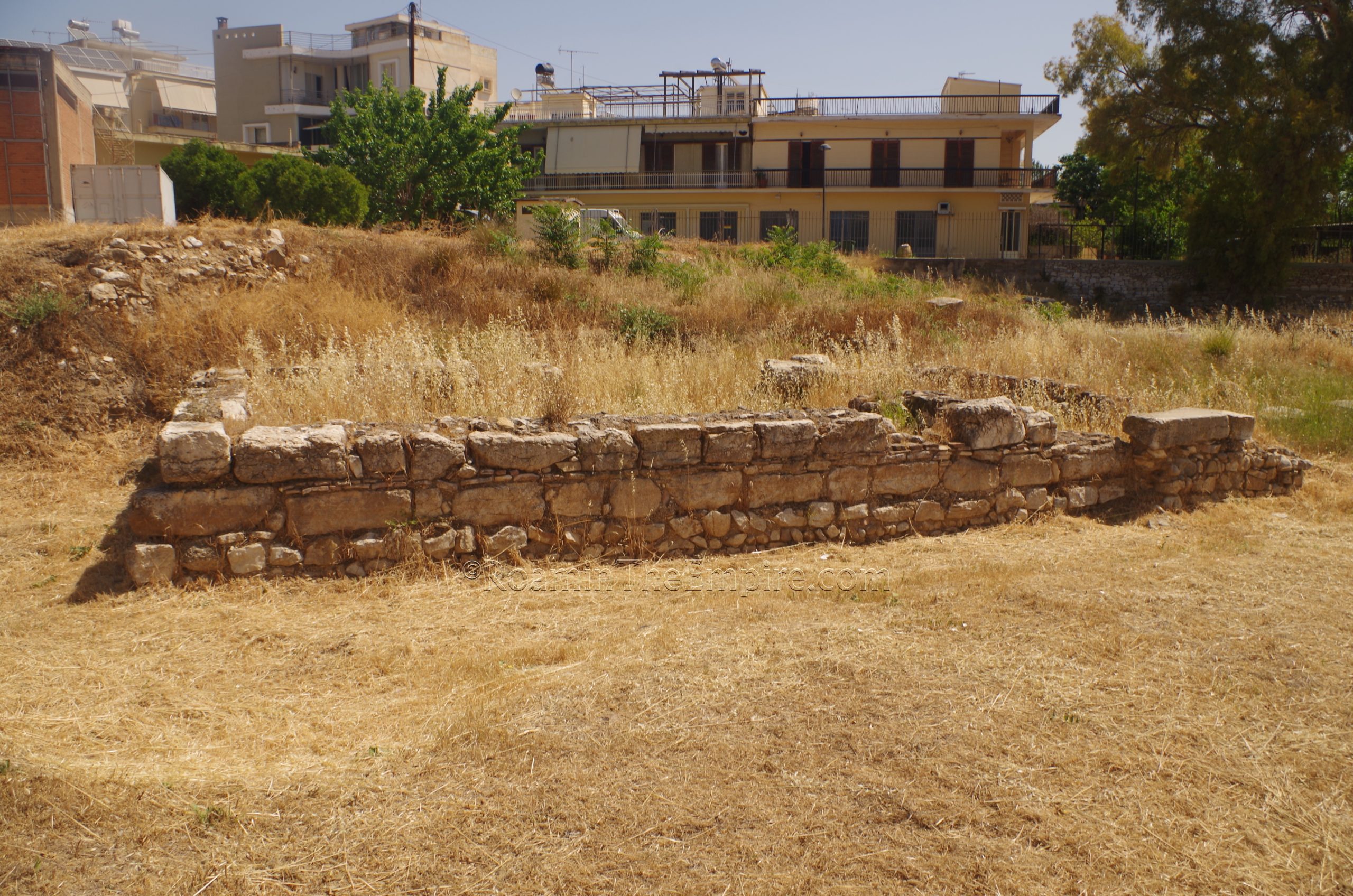
A short distance west of the Tholos is Monument D. The construction here was first built about the 2nd century BCE and served as a pedestal for a monument of unknown use or dedication, though it was believed to be of some importance. By the 3rd century CE, the monument was no longer used and the pedestal on which it stood was used as the base for a small temple. The form of the temple can still be seen, though the deity to whom the temple was dedicated is unknown.
Continuing to the north side of the excavations, some remains of the Northern Gallery and the so-called Agora Theater can be seen. The gallery was first constructed in the 4th century BCE and seemed to have been space for workshops. A sunken semicircular area, the so-called theater, was part of the original building. Two steps made up the depth of the semicircle with enough space to accommodate about 80 people. The remains of an altar in the center suggest the use of the space for rituals as well as general public gatherings. In the 1st century CE, a fire destroyed the Northern Gallery and a larger edifice was constructed in its place. Again, the space was likely dedicated to craft production. At the end of the 2nd century CE, the sunken theater was converted into a cistern.
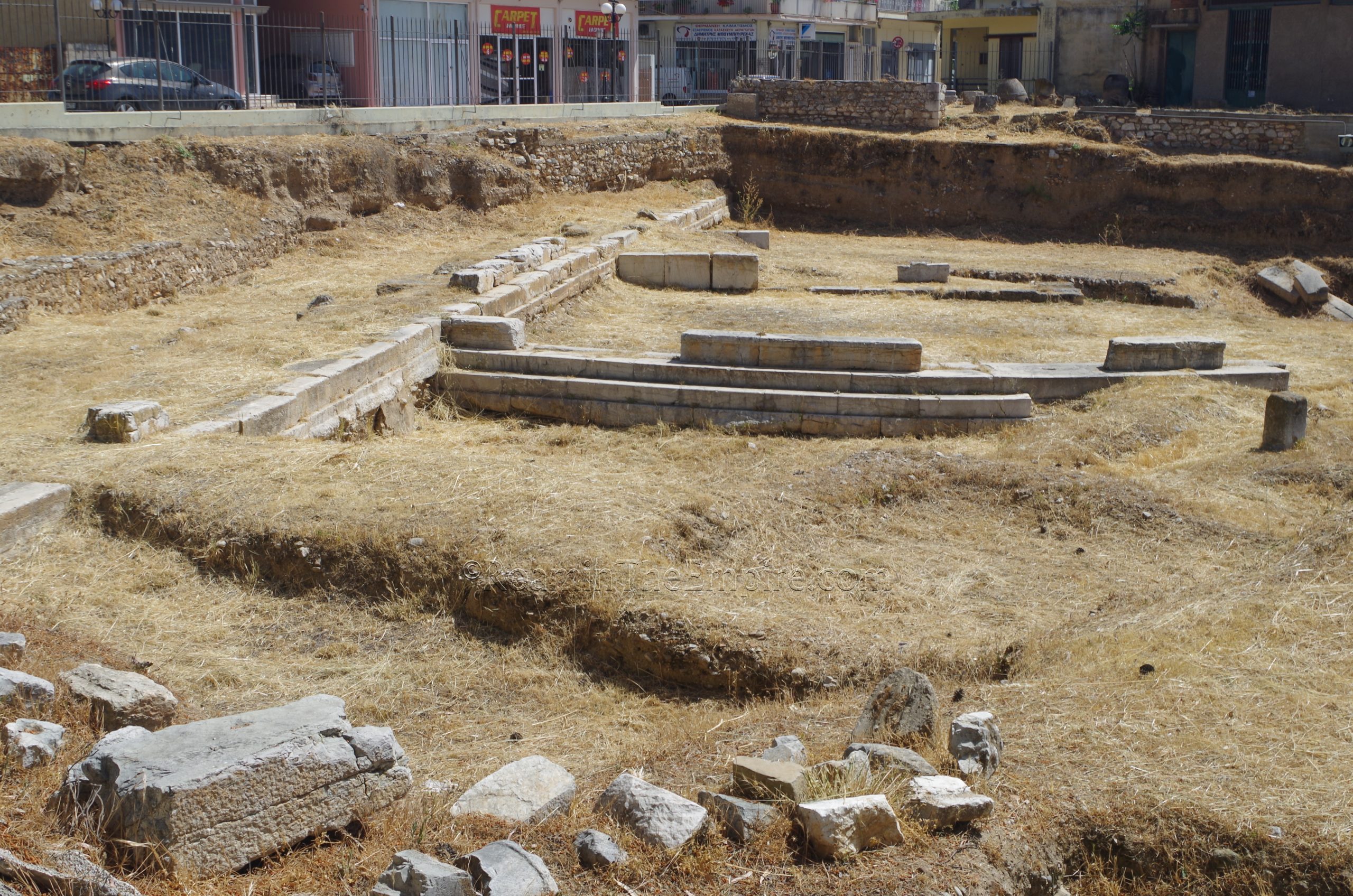
Just adjacent to the semicircular structure of the Agora Theater is a series of 8 blocks set up around a space that is identified as a hearth dating to the 4th century CE. One of these stones sports an inscription regarding the heroes of King Adrastos of Argos who fought against Thebes. This is believed to be part of a 6th century BCE Heroon of Thebes, and perhaps the eternal flame that was described by Pausanias as being dedicated to the legendary founder of Argos, Phoroneus, near the temple of Apollo Lykeios (which has not been identified but is believed to be nearby).
Like the theater area, there are a number of signs, one for each of the monuments, with illustrations, plans, and information in Greek, French, and English. The space is a little less well taken care of than the theater (a bit more overgrowth limiting movement), but most things are fairly visible, if not always accessible.
The previously mentioned nymphaeum to the north of the theater is accessible a few blocks north of the park on Apid street, which branches off to the west from Gounari, which is one of the roads intersecting in front of the theater archaeological area entrance. At the end of Apid Street there is a staircase that almost looks like it belongs to the property owner there, but it is in fact a public access point to the nymphaeum area. The actual nymphaeum is located to the north of the staircase, which was not the original means of access, as a stone staircase that now dead ends into the wall of the house to the north is still preserved.
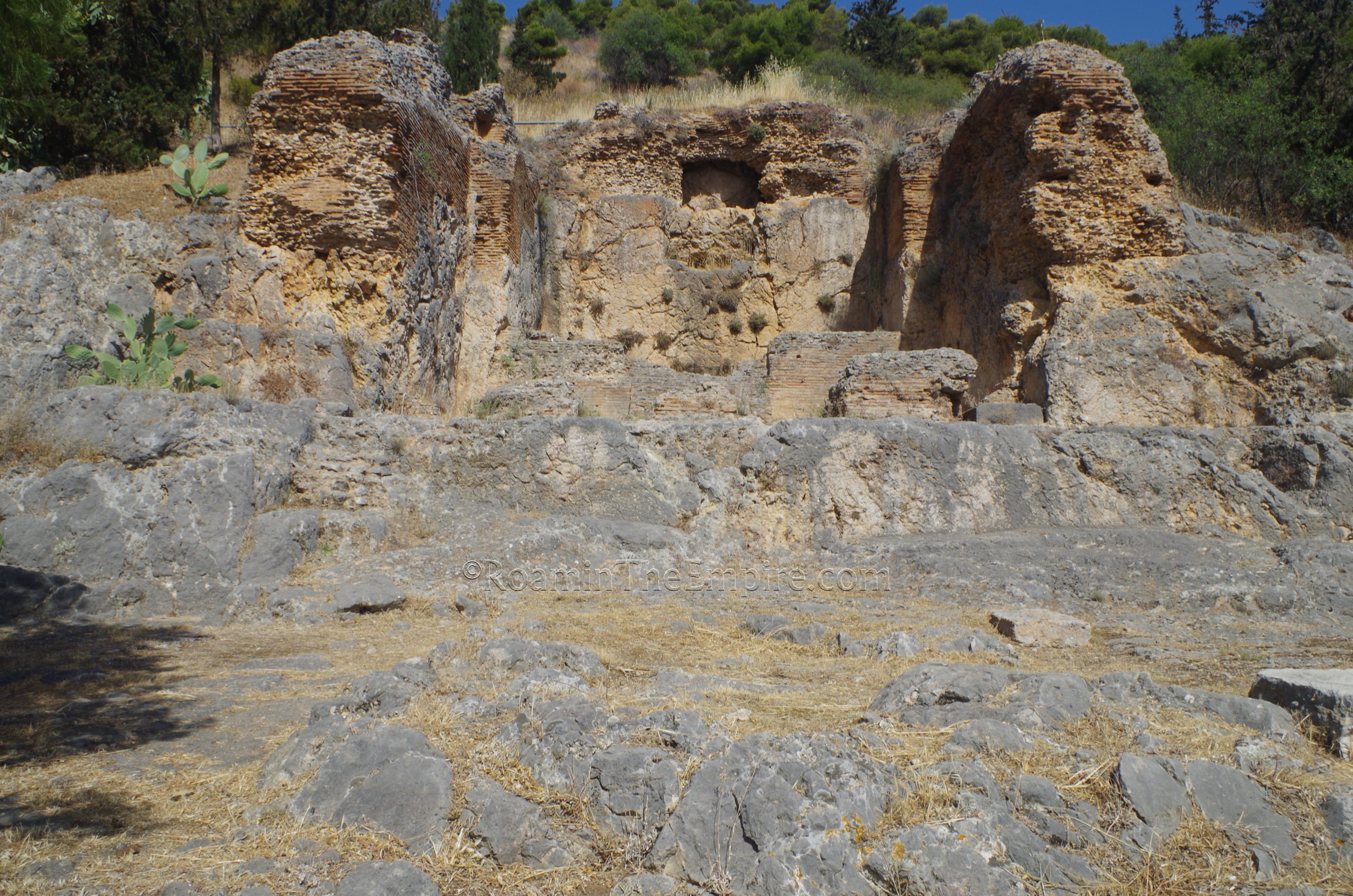
The nymphaeum was built during the Hadrianic period along with the aqueduct that feeds it along this ridge. Part of the structure is carved into the rock of the hill, while there is also significant brick construction as well. The channel leading in from the north, where stretches of the aqueduct remain is visible. Unfortunately, while some significant remains of the aqueduct are still standing to the north (and are visible from subsequent streets to the north), I wasn’t able to get direct access. It is supposedly accessible, but, the apparent path north from the nyphaeum was not much of a path and required a lot of traversing over overgrown, rocky terrain. I tried for a little bit, but had to turn back after about 10 minutes.
The open area to the south of the nymphaeum is identified as being the Kriterion, the open air law court functioning from the 6th century BCE to 3rd century BCE. Some scholars have suggested the Kriterion is in the agora, but Pausanias notes that it was adjacent to a sanctuary to a river god, and the proximity to the later nymphaeum has suggested this location rather than down in the agora. There is evidence to suggest there were sanctuaries elsewhere in the immediate area. Not much is visible of the Kriterion other than a few rectilinear cuts in the rock that seem to be delimiting space in this area. Unfortunately the best signage for the nyphaeum and Kriterion is not on site, but is rather in the area of the theater.
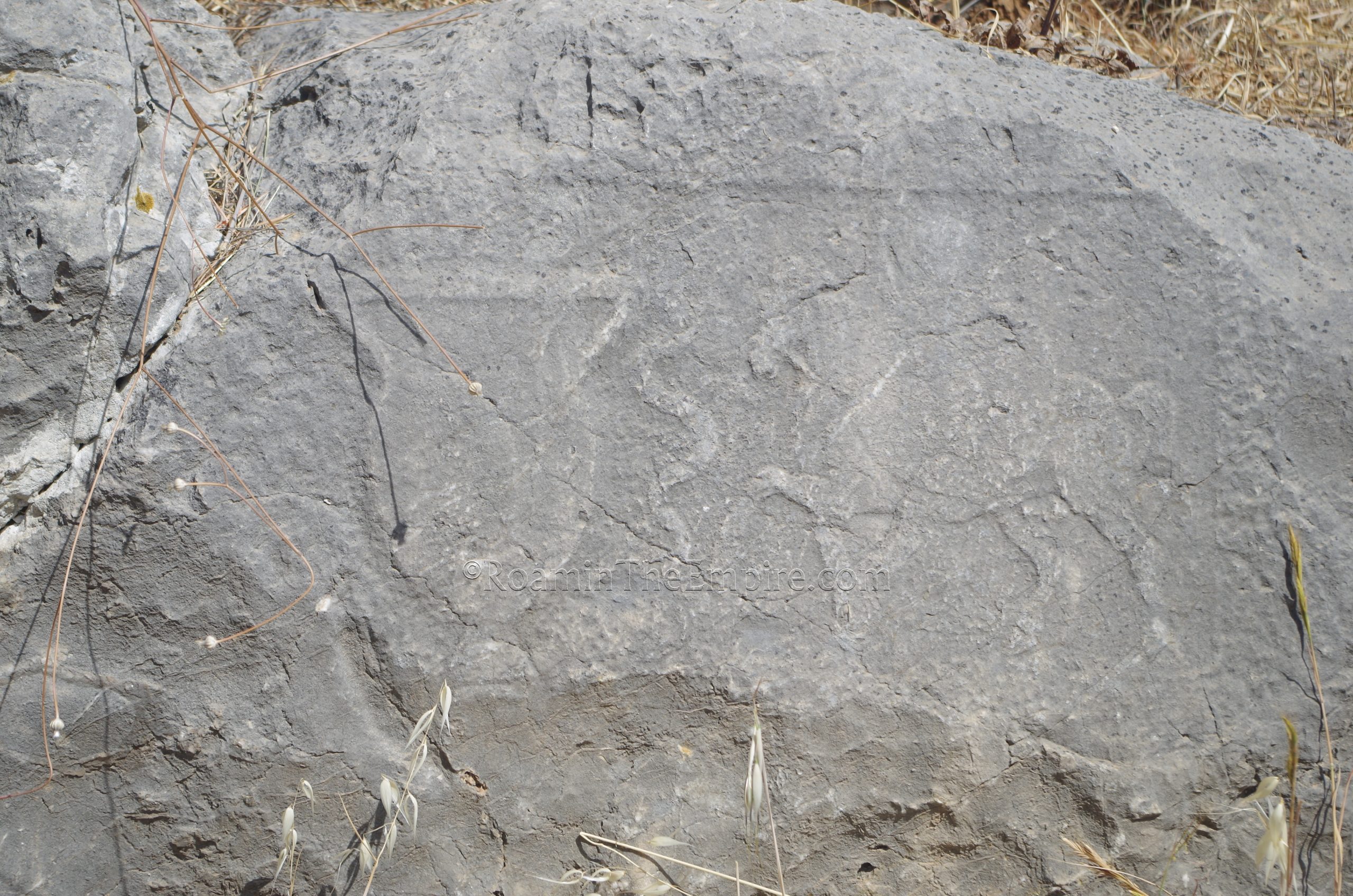
The channel of the aqueduct can be followed through the nymphaeum and leading to the south along a trail. About 50 meters south of the nymphaeum are a series of tanks cut into the rock on the west side of the trail as well as above the trail in the hillside. Some of these are pretty easy to see, others more difficult to make out. But there are a couple of very obvious ones right next to the trail. Some of the channel is also visible in this area. A little bit farther south is the so-called Rider Relief cut into a rock next to the trail. This small relief depicting a cup, a snake, and a rider is dated to the late 4th or early 3rd century BCE. It is thought to have something to do with a chthonic cult, in part due to the imagery but also the proximity to the theater with its special accommodations for chthonic characters.
Heading back out to Gounari and heading north to Foroneos does offer some views of the aqueduct along the hill at points. There is also a fenced in lot, with no direct access, across from Danais Street that contains some remains. These are sometimes described as being associated with the aqueduct, and there is indeed one element of the remains that pokes above the overgrowth that appears to be a channel of some sort. Other than that, though, there is not much information about what is here.
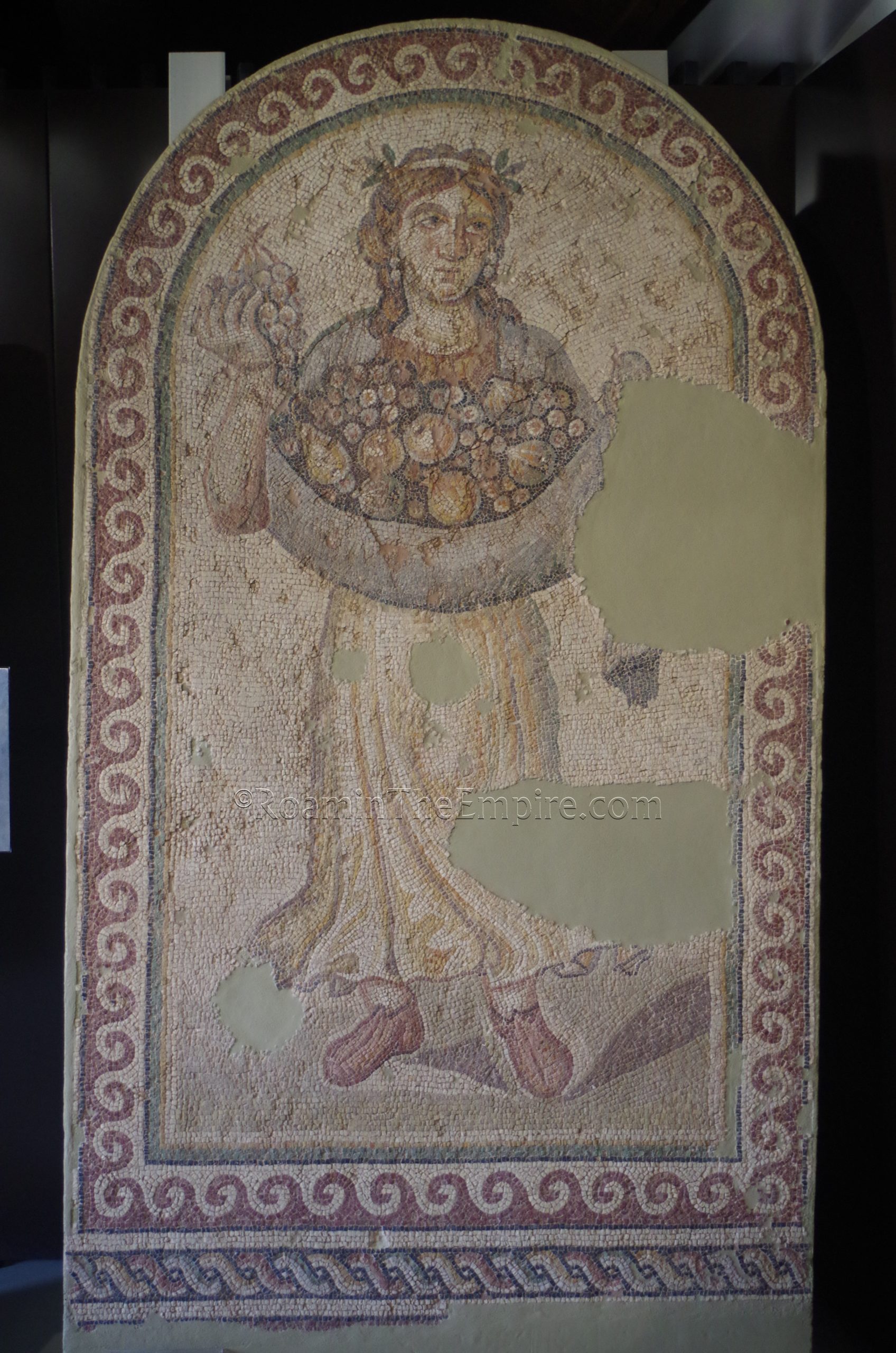
A few blocks to the east is the Byzantine Museum of Argolis, located at the Kapodistria Barracks off Zografou. The museum is open Wednesday through Monday from 8:30 to 15:30 and is closed on Tuesdays. Admission is 4 Euros. As the name would suggest, the museum is geared toward Byzantine artifacts, and the vast majority of the collection dates to post-Roman period. Greek museums have the tendency to treat everything after the start of the 4th century CE as Byzantine, though. As such, there are two phenomenal 4th century CE Roman mosaics on display here depicting a quadriga and the personification of autumn. There are a few other scattered Roman era artifacts, but the mosaics are really the main attractions for that period. Of course, the Byzantine collection itself is worthwhile in and of itself.
Not far from the Byzantine Museum is the Archaeological Museum of Argos. This museum, has, unfortunately been closed for at least 5 years now and there does not seem to be any estimate for reopening. Apparently the gardens are sometimes open with some larger stone artifacts present, but this was certainly not the case when I visited.
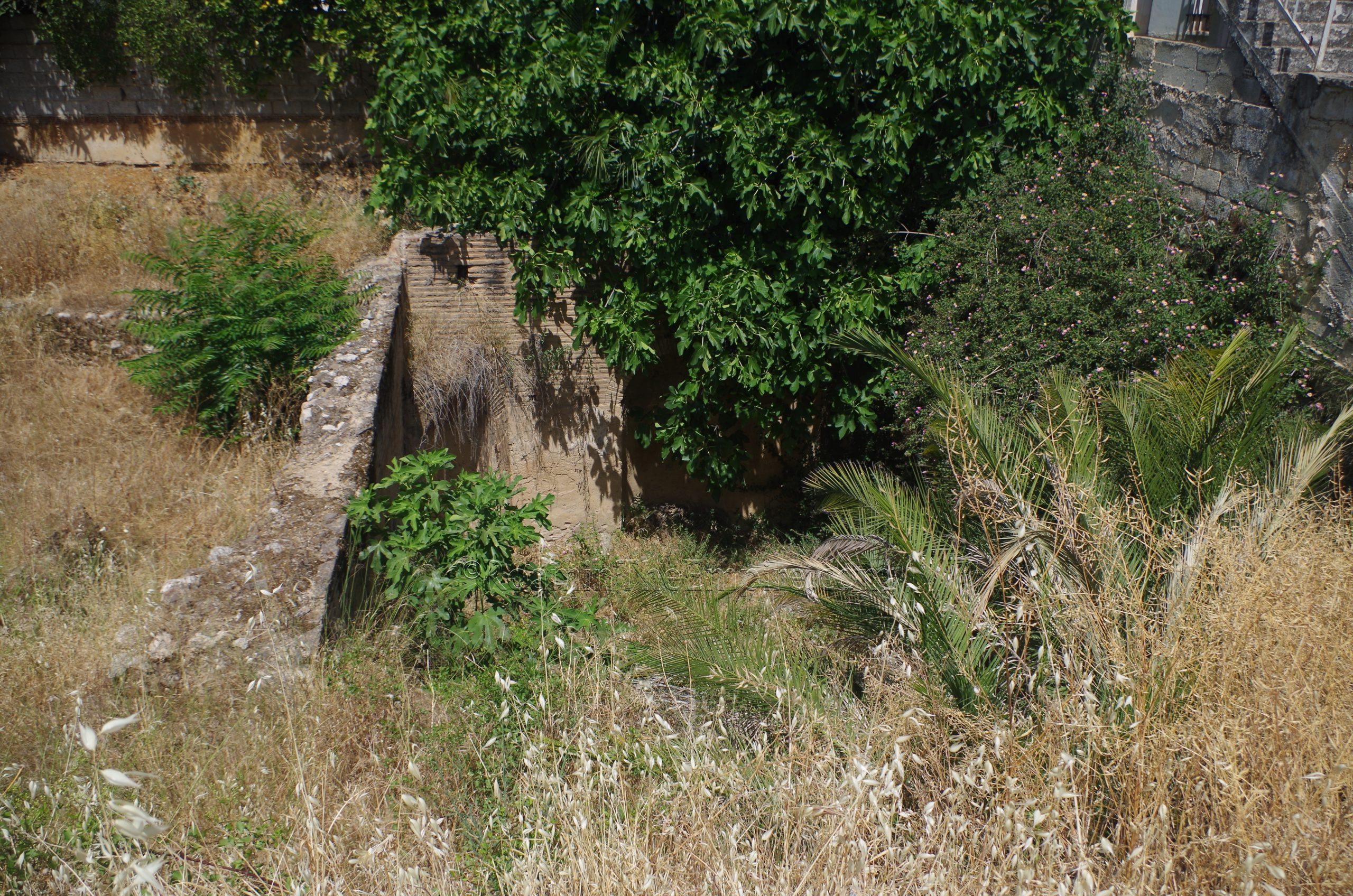
A few blocks south of the museums are some excavated areas on three of the four corners at the intersection of Eth. Antistaseos and Aigaiou Pelagou. There is no information on what is here on site and I’ve been unable to find anything regarding these excavations elsewhere. They may be late Roman or perhaps even later than that. The construction does seem a bit more Byzantine (by the standard of being after the late 5th century CE, rather than the early 4th century CE). The northwest and southwest corners are a bit better maintained (though still somewhat overgrown) but are fenced in, while the southeast corner is not fenced, but is largely overgrown and there isn’t a whole lot to see.
About 375 meters south of that intersection, as the crow flies; about 500 meters walking route, is another seemingly indistinct set of remains along Spiridono Mpousoulopoulou. At one time there seems to have been an informational sign identifying what is here, but it is no longer in a condition to be read. The structure here, however, is identified as being a sanctuary to Isis. It was largely overgrown when I visited, but it could still be seen that significant portions of the walls remain, and that a niche was visible on the back wall of the structure. The brickwork firmly places this building in the Roman period. The connection between Isis and Io, a princess of Argos, makes the presence of a temple sanctuary especially interesting, though there is not much in the way of English language information on the site. Aside from being overgrown, the sanctuary is also fenced, so there is no access.
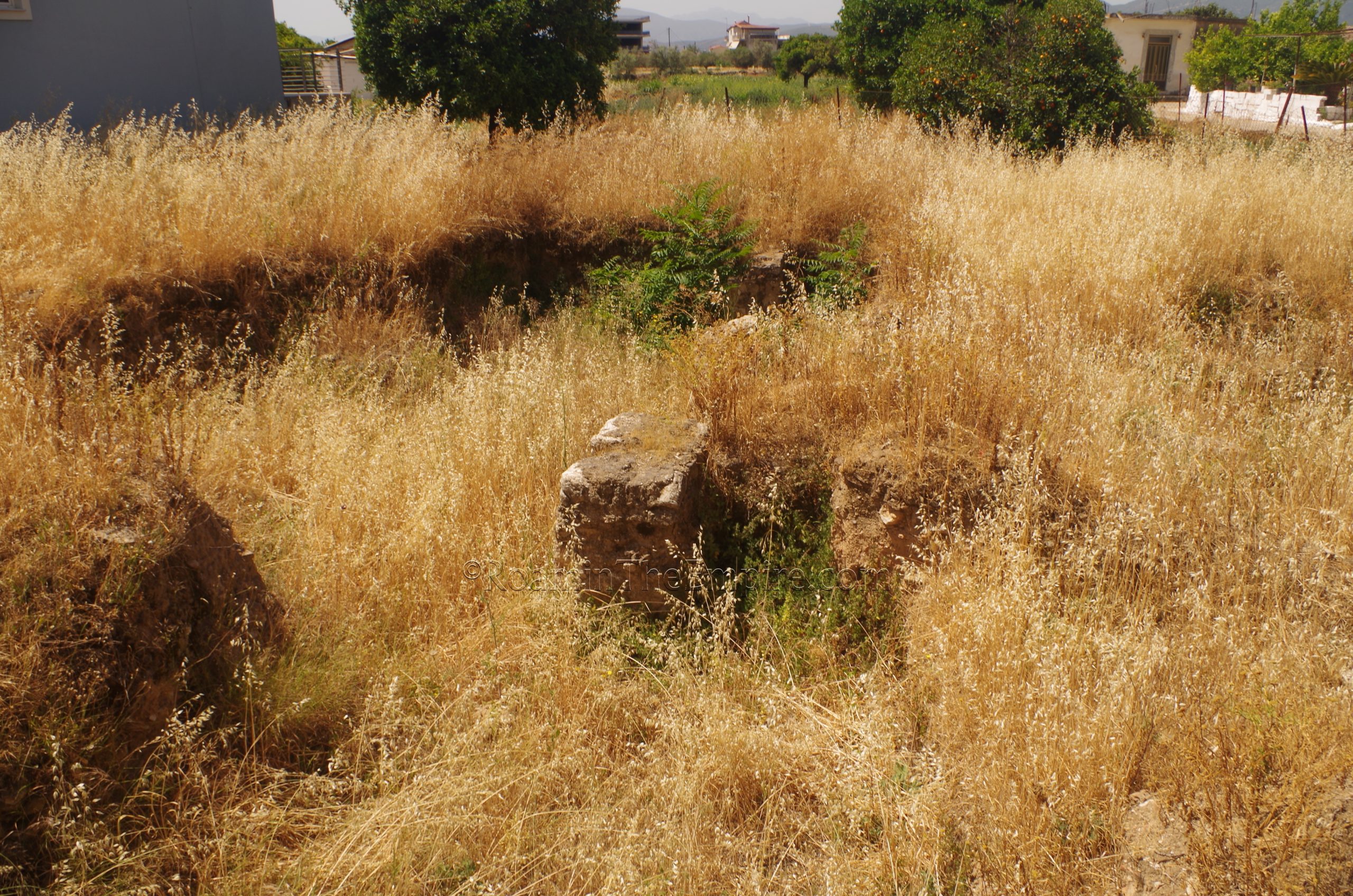
Just a few minutes to the southwest on the corner of Aristofani and Messinias Arkadias is another bit of remains. These were pretty overgrown and there is actually an informational sign visible, but not accessible. The only words I could manage to see on the sign indicated that these structures were Byzantine in origin. The construction type does look a bit more like post-5th century Byzantine rather than 4th century Byzantine.
The final bit in the loop through the central part of Argos is just one street to the south, at Messinias Arkadias and Archeas Voulis. Like the Byzantine building, this too once had an accessible information sign, but it is now behind a fence and facing away from the street, so it can’t be seen. This area, which is now not very far from the agora (only 140 meters from the South Gallery), is identified as being a temple, defined as Temple K. The oldest building phase of this temple is the 4th century BCE, but there was probably a temple here as early as the 5th century BCE. Renovations were conducted in the 3rd and 2nd centuries BCE as well as the 1st century CE. The site seems to match up with a description by Pausanias of temples to Athena Salpinx, Hera Antheia, and Demeter Pelasgus, of which it is suspected this must be one of the three.
Continued in Argos Part III
Sources:
Diodorus Siculus. Bibliotheca Historica, 11.65, 12.75.
Grant, Michael. A Guide to the Ancient World: A Dictionary of Classical Place Names. New York: Barnes & Noble Books, 1997.
Hall, Jonathan M. Reclaiming the Past: Argos and Its Archaeological Heritage in the Modern Era. Cornell, NJ: Cornell University Press, 2021.
Herodotus. Historiai, 6.76-6.85, 6.92. 7.148-7.150.
Homer. Illiad, 4.51-52.
Livy. Ab Urbe Condita, 32.25. 34.25-34.41.
Longfellow, Brenda. “The Legacy of Hadrian: Roman Monumental Civic Fountains in Greece.” The Nature and Function of Water, Baths, Bathing, and Hygeiene from Antiquity through the Renaissance. Leiden: Brill, 2009.
Miller, Stephen G. “The Date of the West Building at the Argive Heraion.” Archaeology. Vol. 77, No 1 (Jan. 1973), pp. 9-18.
Pausanias. Hellados Periegesis, 2.15.5, 2.17, 2.19.3-2.24.4, 2.25.7, 2.26.1, 2.35.2, 8.27.1.
Plutarch. Aratus, 34-35.
Plutarch. Pyrrhus, 34.
Polybius. Historiai, 2.44, 2.52-2.54. 2.70.
Smith, William. Dictionary of Greek and Roman Geography. Walton & Murray, 1870.
Stillwell, Richard, William L. MacDonald, and Marian Holland. McAllister. The Princeton Encyclopedia of Classical Sites. Princeton, NJ: Princeton U Press, 1976.
Strabo. Geographika, VIII.5-6.
Thucydides. Historiai, 4.133, 5.14, 5.29-5.82.
Tomlinson, R.A. Argos and the Argolid: From the End of the Bronze Age to the Roman Occupation. New York: Routledge & Kegan Paul Ltd., 1972.
Xenephon. Hellenica, 7.5.5.


